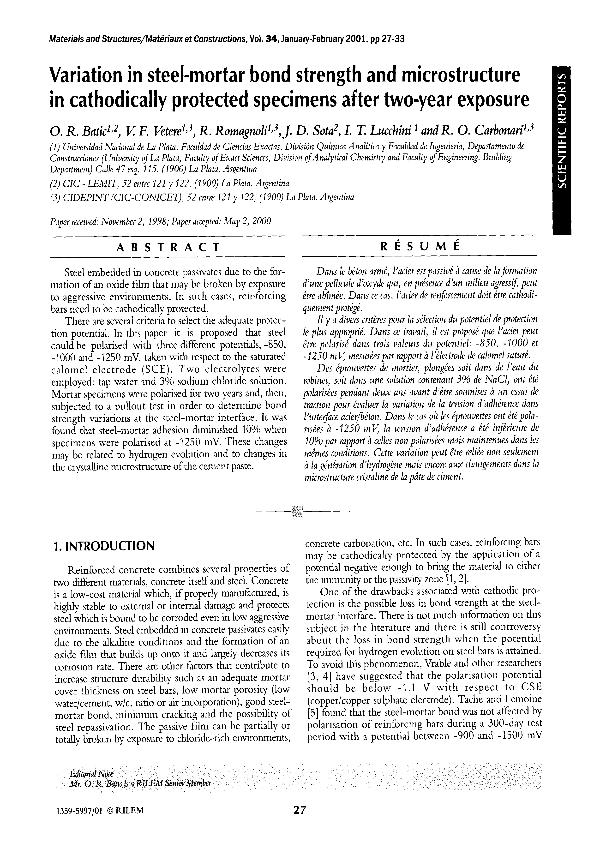Mostrar el registro sencillo del ítem
dc.contributor.author
Batic, O. R.
dc.contributor.author
Vetere, Vicente Francisco

dc.contributor.author
Romagnoli, Roberto

dc.contributor.author
Sota, Jorge Daniel

dc.contributor.author
Lucchini, I.T.
dc.contributor.author
Carbonari, Ricardo Obdulio

dc.date.available
2022-02-14T21:18:10Z
dc.date.issued
2001-01
dc.identifier.citation
Batic, O. R.; Vetere, Vicente Francisco; Romagnoli, Roberto; Sota, Jorge Daniel; Lucchini, I.T.; et al.; Variation in steel-mortar bond strength and microstructure in cathodically protected specimens after two-year exposure; Springer; Materials And Structures; 34; 1; 1-2001; 27-33
dc.identifier.issn
1359-5997
dc.identifier.uri
http://hdl.handle.net/11336/151975
dc.description.abstract
Steel embedded in concrete passivates due to the formation of an oxide film that may be broken by exposure to aggressive environments. In such cases, reinforcing bars need to be cathodically protected. There are several criteria to select the adequate protection potential. In this paper it is proposed that steel could be polarised with three different potentials,-850, -1000 and -1250 mV, taken with respect to the saturated calomel electrode (SCE). Two electrolytes were employed: tap water and 3% sodium chloride solution. Mortar specimens were polarised for two years and, then, subjected to a pullout test in order to determine bond strength variations at the steel-mortar interface. It was found that steel-mortar adhesion diminished 10% when specimens were polarised at -1250 mV. These changes may be related to hydrogen evolution and to changes in the crystalline microstructure of the cement paste.
dc.description.abstract
Dans le béton armé, l'acier est passivé à cause de la formation d'une pellicule d'oxyde qui, en présence d'un milieu agressif, peut être abîmée. Dans ce cas, l'acier de renforcement doit être cathodiquement protégé. Il y a divers critères pour la sélection du potentiel de protection le plus approprié. Dans ce travail, il est proposé que l'acier peut être polarisé dans trois valeurs du potentiel: −850, −1000 et −1250 mV, mesurées par rapport à l'électrode de calomel saturé. Des éprouvettes de mortier, plongées soit dans de l'eau du robinet, soit dans une solution contenant 3% de NaCl, ont été polarisées pendant deux ans avant d'être soumises à un essai de traction pour évaluer la variation de la tension d'adhérence dans l'interface acier/béton. Dans le cas où les éprouvettes ont été polarisées à −1250 mV, la tension d'adhérence a été inférieure de 10% par rapport à celles non polarisées mais maintenues dans les mêmes conditions. Cette variation peut être reliée non seulement à la génération d'hydrogène mais encore aux changements dans la microstructure cristaline de la pâte de ciment.
dc.format
application/pdf
dc.language.iso
eng
dc.publisher
Springer

dc.rights
info:eu-repo/semantics/openAccess
dc.rights.uri
https://creativecommons.org/licenses/by-nc-sa/2.5/ar/
dc.subject
Bond Strength
dc.subject
Hydrogen Evolution
dc.subject
Ettringite
dc.subject
Calcium Silicate Hydrate
dc.subject
Pullout Test
dc.subject.classification
Otras Ciencias Químicas

dc.subject.classification
Ciencias Químicas

dc.subject.classification
CIENCIAS NATURALES Y EXACTAS

dc.title
Variation in steel-mortar bond strength and microstructure in cathodically protected specimens after two-year exposure
dc.type
info:eu-repo/semantics/article
dc.type
info:ar-repo/semantics/artículo
dc.type
info:eu-repo/semantics/publishedVersion
dc.date.updated
2020-11-30T13:48:42Z
dc.identifier.eissn
1871-6873
dc.journal.volume
34
dc.journal.number
1
dc.journal.pagination
27-33
dc.journal.pais
Alemania

dc.description.fil
Fil: Batic, O. R.. Universidad Nacional de La Plata. Facultad de Ciencias Exactas; Argentina. Provincia de Buenos Aires. Gobernación. Comisión de Investigaciones Científicas; Argentina
dc.description.fil
Fil: Vetere, Vicente Francisco. Provincia de Buenos Aires. Gobernación. Comisión de Investigaciones Científicas. Centro de Investigaciones en Tecnología de Pinturas. Consejo Nacional de Investigaciones Científicas y Técnicas. Centro Científico Tecnológico Conicet - La Plata. Centro de Investigaciones en Tecnología de Pinturas; Argentina. Universidad Nacional de La Plata. Facultad de Ciencias Exactas; Argentina
dc.description.fil
Fil: Romagnoli, Roberto. Provincia de Buenos Aires. Gobernación. Comisión de Investigaciones Científicas. Centro de Investigaciones en Tecnología de Pinturas. Consejo Nacional de Investigaciones Científicas y Técnicas. Centro Científico Tecnológico Conicet - La Plata. Centro de Investigaciones en Tecnología de Pinturas; Argentina. Universidad Nacional de La Plata. Facultad de Ciencias Exactas; Argentina
dc.description.fil
Fil: Sota, Jorge Daniel. Provincia de Buenos Aires. Gobernación. Comisión de Investigaciones Científicas; Argentina
dc.description.fil
Fil: Lucchini, I.T.. Universidad Nacional de La Plata. Facultad de Ciencias Exactas; Argentina
dc.description.fil
Fil: Carbonari, Ricardo Obdulio. Provincia de Buenos Aires. Gobernación. Comisión de Investigaciones Científicas. Centro de Investigaciones en Tecnología de Pinturas. Consejo Nacional de Investigaciones Científicas y Técnicas. Centro Científico Tecnológico Conicet - La Plata. Centro de Investigaciones en Tecnología de Pinturas; Argentina. Universidad Nacional de La Plata. Facultad de Ciencias Exactas; Argentina
dc.journal.title
Materials And Structures

dc.relation.alternativeid
info:eu-repo/semantics/altIdentifier/doi/http://dx.doi.org/10.1007/BF02482197
dc.relation.alternativeid
info:eu-repo/semantics/altIdentifier/url/https://link.springer.com/article/10.1007/BF02482197
Archivos asociados
